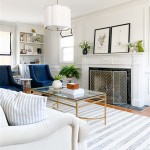What Color To Paint Your Living Room
Selecting a color to paint a living room is a significant decision that impacts the overall ambiance, perceived size, and aesthetic appeal of the space. The living room often serves as a central gathering area for families and guests, making it crucial to choose a color that reflects the desired mood and harmonizes with existing furnishings and décor.
The process of choosing the right color involves considering various factors, including the room's size, natural lighting, the style of furniture, personal preferences, and the psychological effects of different colors. A well-chosen color can transform a dull space into a vibrant and inviting environment, while an unsuitable choice can lead to a feeling of discomfort or disharmony.
Understanding the fundamentals of color theory is beneficial when making color choices. Color theory encompasses the relationships between colors, including primary, secondary, and tertiary colors, as well as concepts like hue, saturation, and value. Familiarity with these principles aids in creating a balanced and visually appealing color scheme.
Understanding Room Size and Lighting
The size of the living room is a primary consideration when selecting a paint color. Smaller living rooms generally benefit from lighter colors, as these shades tend to reflect more light, creating an illusion of spaciousness. Darker colors, conversely, absorb light and can make a small room feel even smaller and more enclosed. This effect is due to the way our eyes perceive light and shadow, and how it affects the perceived dimensions of a room.
Larger living rooms, on the other hand, offer more flexibility in color choices. While light colors remain a viable option, darker and more saturated hues can be used to create a sense of intimacy and warmth. In a large space, a darker color can anchor the room and prevent it from feeling too vast or impersonal. The key is to balance the color with sufficient lighting and complementary décor elements.
Natural lighting plays a critical role in how a paint color appears in a living room. Rooms with abundant natural light can handle a wider range of colors, including cooler shades, without feeling cold or unwelcoming. The sunlight helps to brighten and balance the color, ensuring it doesn't appear too harsh or overwhelming.
Living rooms with limited natural light require a different approach. In these spaces, lighter, warmer colors are often the best choice. These colors reflect what little light is available, brightening the room and making it feel more inviting. Using colors with warm undertones, such as yellows or oranges, can further enhance the sense of warmth and combat the lack of natural light.
Artificial lighting also influences how a paint color is perceived. Incandescent lighting tends to cast a warm glow, which can enhance warm colors while making cool colors appear duller. Fluorescent lighting, on the other hand, tends to cast a cooler, bluer light, which can accentuate cool colors and make warm colors appear flat. LED lighting offers a range of color temperatures, allowing for more control over the overall lighting effect. When selecting a paint color, it's important to consider the type of lighting used in the living room and how it will affect the appearance of the chosen color.
Color Psychology and Emotional Impact
Colors have a psychological impact on individuals, influencing mood, emotions, and behavior. Understanding these effects can help in selecting a paint color that creates the desired atmosphere in the living room. Different colors evoke distinct feelings, and choosing a color that aligns with the intended use of the space is crucial.
Blue is often associated with calmness, serenity, and relaxation. It's a popular choice for living rooms intended as peaceful retreats. Lighter shades of blue can create a soothing and airy ambiance, while darker shades can add depth and sophistication. Overdoing blue can, however, give a space a cool or even depressing touch if not balanced properly.
Green is linked to nature, growth, and harmony. It's a versatile color that can evoke feelings of tranquility and balance. Lighter greens can create a fresh and inviting atmosphere, while darker greens can add a sense of richness and depth. Green is generally a neutral choice that pairs well with a variety of décor styles.
Yellow is associated with optimism, joy, and energy. It's a cheerful color that can brighten up a living room and create a welcoming atmosphere. However, yellow can be overwhelming in large doses, so it's often best used as an accent color or in lighter shades. The psychological effect of yellow means it can be perceived as stimulating, but also associated with frustration if not properly implemented.
Red is linked to passion, energy, and excitement. It's a bold color that can add drama and warmth to a living room. However, red can be overpowering, so it's best used sparingly or in muted shades. It is a color capable of eliciting strong emotions and should be used judiciously.
Orange is associated with enthusiasm, creativity, and warmth. It's a vibrant color that can add a playful touch to a living room. Like yellow, orange can be overwhelming in large doses, so it's often best used as an accent color or in muted shades. The combination of red's energy and yellow's happiness makes orange a versatile but potentially overstimulating choice.
Neutral colors, such as white, gray, beige, and cream, provide a versatile backdrop that can be easily adapted to different styles and preferences. These colors are often used to create a sense of calm and sophistication, and they allow for greater flexibility in decorating with furniture, artwork, and accessories. Neutral colors also tend to make a room feel larger and brighter.
Coordinating with Existing Furnishings and Décor
The existing furniture, flooring, and décor in the living room play a significant role in determining the best paint color. The goal is to create a cohesive and harmonious look that reflects personal style and preferences. This involves considering the color palette of existing elements and selecting a paint color that complements or contrasts them effectively.
If the living room features furniture with bold colors or patterns, a neutral paint color may be the best choice. This will allow the furniture to take center stage without overwhelming the space. Conversely, if the furniture is neutral, a bolder paint color can be used to add personality and visual interest.
The flooring material and color should also be considered. Hardwood floors, for example, often pair well with warmer paint colors, while tile floors may complement cooler shades. The color of the flooring can influence the overall tone of the room, so it's important to choose a paint color that harmonizes with it.
When selecting a paint color, it's helpful to gather samples and test them in the living room. Paint colors can look different under different lighting conditions, so it's important to see how they appear in the actual space. Applying small swatches of different colors to the wall and observing them at different times of day can help in making the best decision.
Consider the architectural style of the house. Modern homes often benefit from clean, minimalist color palettes, while traditional homes may call for richer, more saturated colors. Matching the design palette to the home's style enhances its intrinsic character and prevents a clash of styles.
Details such as trim, moldings, and architectural features also influence the choice of paint color. These elements can be highlighted with contrasting colors or blended seamlessly with the wall color, depending on the desired effect. When considering trim and moldings, selecting complementary or contrasting neutrals can provide depth without overcomplicating the room's aesthetic.
Ultimately, the best color to paint a living room is a matter of personal taste and preference. However, by considering the factors discussed above, it's possible to make an informed decision that creates a beautiful and inviting space that reflects individual style and enhances the overall ambiance of the home. A considered approach to colour selection will provide a long-lasting and satisfying environment.

5 Best Colors To Paint Your Living Room First Place Painting

8 Vibrant Living Room Paint Color Ideas Dumpsters Com

How To Use Bold Paint Colors In Your Living Room

Dulux Living Room Paint Colours

50 Best Living Room Paint Colors Top From Designers

Popular Paint Colors For Your Living Room Rob Ross Painting

30 Living Room Color Ideas Best Paint Decor Colors For Rooms

Guide To Warm And Cool Paint Colors Beamin Moore

Find The Right Color For Your Living Room
:strip_icc()/cdn.cliqueinc.com__cache__posts__261477__small-living-room-paint-colors-261477-1529967319237-image.700x0c-4c6e6bd8e8214a9786d2b8045f6dbdf4.jpg?strip=all)
10 Best Paint Colors For Small Living Rooms








